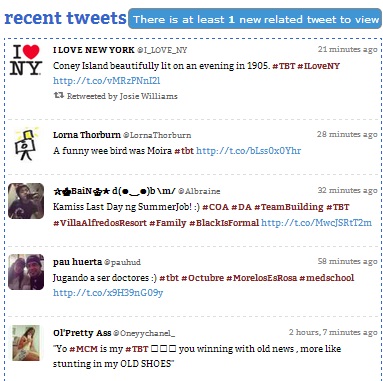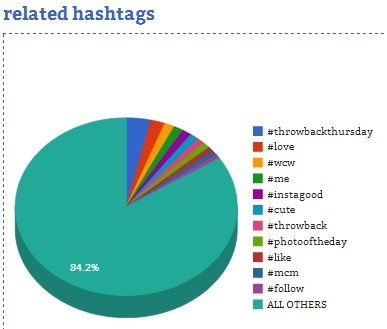Businesses are becoming deeply involved in social media as they aim to gain more followers and establish their name in the industry. Find out which social media platform will work best based on your objectives and level of social media activity.
 Courtesy of Hashtags.org Analytics
Now see how the activity spikes every Thursday in a span of one month.
Courtesy of Hashtags.org Analytics
Now see how the activity spikes every Thursday in a span of one month.
 Courtesy of Hashtags.org Analytics
These are the related hashtags used with #TBT in the past month.
Courtesy of Hashtags.org Analytics
These are the related hashtags used with #TBT in the past month.
 Courtesy of Hashtags.org Analytics
There are also other ways to track performance such as observing if you?ve gained new friends or followers online or if sales increased after the campaign. Prepare for the next campaign and keep comparing the details to know your strengths and weaknesses.
Courtesy of Hashtags.org Analytics
There are also other ways to track performance such as observing if you?ve gained new friends or followers online or if sales increased after the campaign. Prepare for the next campaign and keep comparing the details to know your strengths and weaknesses.
Where to Start Your Social Media Account for Business
The top 3 sites for business are Twitter, Facebook and LinkedIn. Twitter is focused on micro-blogging, where online users make use of short messages or ?tweets? having a maximum limit of only 140 characters. Create a Twitter account by providing a short description on what the business is about, your specific objectives and a link to an existing blog, if any. Customers can follow if they find your posts interesting. Facebook focuses more on actual profile pages where you can include full descriptions on background and details of the business establishment. You can also upload photos and videos and add friends who will see your posts in their feeds just like Twitter. LinkedIn is a social media site focused on job seekers and potential employers. You can look for key workers and marketers who can help grow your business quickly. Searches can be made more specific so you actually target relevant users based on their interests and skills. All of these three have millions of active users each month that can immediately spread brand awareness and boost productivity.Vital Elements of an Effective Social Media Account
1. Good quality content
Content is the most important element of a successful social media account. Present your business in a brief, interesting and informative way to immediately drive the right individuals. You can gain followers or fans based on the description you provide in the account. Post relevant topics that are highly related to the industry and learn how to make use of the various tools that grab interest like photos, blogs and links to articles and related websites. The frequency and timing of the tweets or posts should be properly timed. Learn when the target market is most likely logging on to the website. Provide updates and feature products during these specific times. Post moderately throughout the day but be careful not to flood the feeds of online users. Also interact with others? posts by answering questions or sharing information in hashtags or online conversations.3. Visual appeal
Provide original and unique photos and videos to stand out from other posts. Even on Twitter or LinkedIn, provide visual elements to increase engagement. Graphs, charts and other similar presentations will work equally.4. Customer support
Be available at crucial times and stay updated with recent developments and trends in the industry. You should answer queries within a reasonable period of time and provide accurate data not available elsewhere. Use private messaging and other communication tools to respond to clients. Since many use mobile devices today to log on to social media sites, expect interactions any time of the day regardless of the location.How to Track Performance
Using social analytics tools or hashtag analytics programs provide accurate information on how your hashtag or marketing campaign is doing online. You can determine how well the campaign did within a 24-hour period or longer to a month. You can point out key individuals who will be equally helpful in future campaigns. You can measure actual user engagement by determining how many responses or retweets the posts garnered. Some programs even show graphs to give you the peak hours and lowest points. To give you an idea how these would look, let's take the popular hashtag #TBT (short for Throwback Thursday, which users latch onto their posts every Thursday along with an old photo or memory.) Here's what the usual #TBT posts look like. Courtesy of Hashtags.org Analytics
Courtesy of Hashtags.org Analytics Courtesy of Hashtags.org Analytics
Courtesy of Hashtags.org Analytics Courtesy of Hashtags.org Analytics
Courtesy of Hashtags.org Analytics


